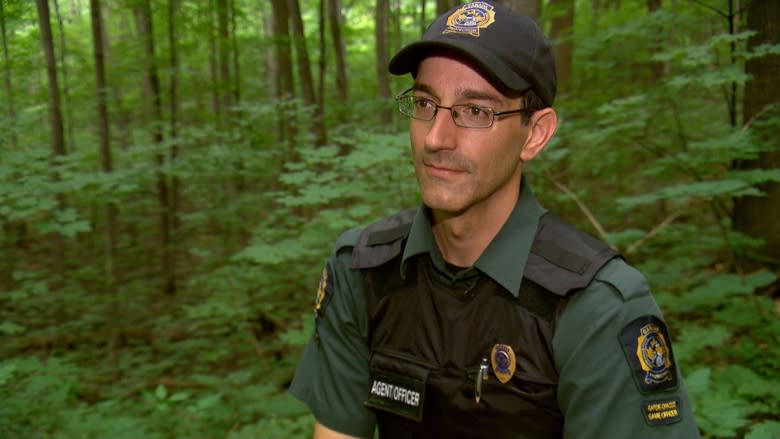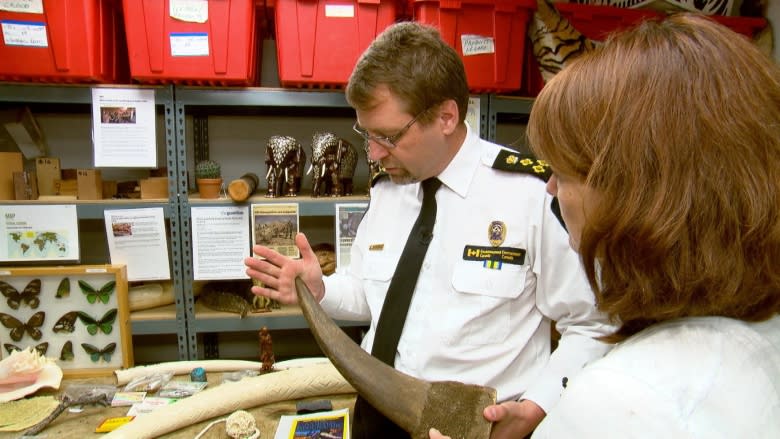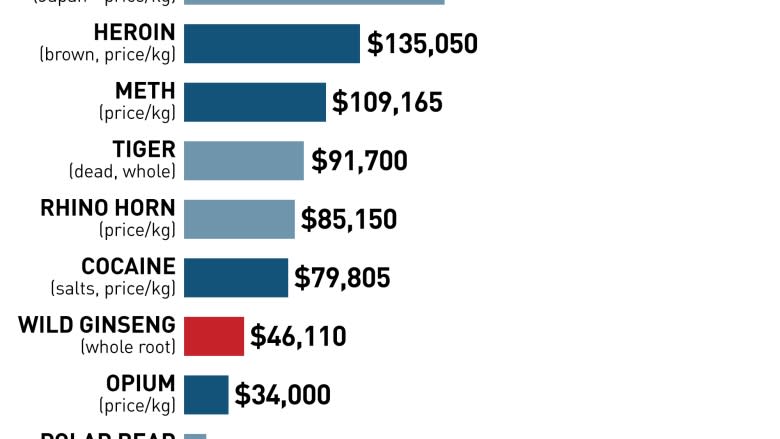Canada's endangered wild ginseng under threat from poachers
Conservation officers in Ontario and Quebec are using surveillance and other techniques to try to outsmart thieves bent on digging up Canada's most valuable endangered plant.
Poaching poses the greatest threat to wild American ginseng, which can sell for anywhere from several hundred to several thousand dollars per root depending on its shape and size. A single root the size of an adult male's finger can fetch up to $1,000.
On the front lines of the preservation effort is an Ottawa-area botanist and senior wildlife enforcement officer for Environment Canada.
In French, Dubois means "from the wood," and if anyone has lived up to that name, it's Jean-François Dubois. He's spent more than 15 years scouring local forests for wild ginseng.
"Before I found my first one, I looked for at least five or six years, every weekend," he said.
That was 14 years ago. Since then, Dubois has discovered several other patches, which are now all under constant motion-triggered video surveillance.
Walking on the forest floor thick with wild ginger, sasparilla and maple saplings, Dubois smiles broadly as he recalls his first find.
"Almost like winning the lottery. It was such a moment for me. So many emotions when I first saw it because I had read so much about it," he said.
'This is our ivory'
Under a high canopy of butternut and maple trees, Dubois points to a cluster of wild ginseng he discovered in 2011.
"Oh, there's a nice one!," he says, squatting down and pointing to the pale green fruit in the middle of the plant.
"This is good news. When you see fruit, it means that maybe there's a chance that there's going to be a small one growing in a year and a half."
This patch only has around 50 plants, falling far short of a viable population. Dubois says wild ginseng populations need at least 170 plants to survive and thrive. Anything less tends to die off over time and disappear.
Across Canada, he says, there are only two dozen or so viable populations of wild American ginseng. It has been designated a species at risk of extinction in Canada.
"This is our ivory. This is our rhino horn," Dubois said. "It's a plant, it doesn't bleed, it doesn't cry, but it's in danger of extinction here in Canada. We have to do something."
Wild American ginseng grows in southern Ontario and western Quebec all the way down to Georgia and Louisiana in the United States. French settlers started exporting it to China 300 years ago, and at one point, it was New France's biggest export after fur.
Ginseng root has long been used in traditional Chinese medicine for ailments such as anxiety and digestive problems. Some believe it's also an aphrodisiac.
That early over-harvesting by settlers kicked off a decline that has accelerated in the last decade because of loss of habitat and the biggest threat: poaching.
In the United States, where the plant has not yet been declared endangered, the misadventures of ginseng poachers and growers are the focus of cable TV shows such as Appalachian Outlaws and Smoky Mountain Money.
Weak penalties
But Canada has its own share of thieves. Penalties for picking wild ginseng include fines of up to $250,000 and one year in jail, but no Canadian judge has ever imposed anything approaching the maximum sentence.
Last year, two men who pleaded guilty to picking ginseng in southern Ontario received fines of $5,000 and $4,000 as well as four-month suspended sentences.
"In Canada, and generally speaking around the world, penalties for [violating] environmental laws are quite low compared to other types of crimes, mainly because they don't see a human victim there," said Sheldon Jordan, director general of wildlife enforcement for Environment Canada.
"Wildlife crime is actually one of the largest forms of crime out there. It's the fourth-largest after illegal drugs, human trafficking and corruption," he said.
At their meeting earlier this month in Germany, G20 leaders issued a declaration in which they committed to focusing attention on the illegal wildlife trade, which in this case includes both flora and fauna.
"Worth an estimated eight to 20 billion euro ($12-30 billion Canadian) annually, illegal trade in wildlife and wildlife products is, due to high demand, one of the largest and most profitable forms of organized cross-border crime with links to financing armed conflicts and possibly terrorism," reads the declaration.
Jordan welcomes the attention.
"This is more than just conservation, saving cute animals, this is also a really big economic issue that impacts all of us," he said.
Conservation though, is Dubois's job. In addition to surveillance, he says people are also marking ginseng roots with ultraviolet dyes to deter poachers.
"They can't sell it [when it's dyed]. So, usually they will go away and leave the rest of the population alone," explained Dubois.
And in the meantime, he continues to explore the woods for more wild ginseng to protect and looks forward to the day his young son will be able to join him.
"Maybe in 10 years, he will be old enough to follow me in the field and see this is American ginseng. This is what your father was working to save, and you see, it's still here."





